A NIGHT AT THE OPERA—AT THE ROMAN ARENA, VERONA
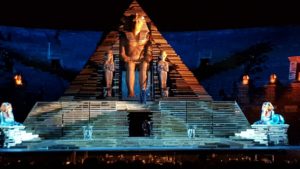
This year was the 96th season of opera to be held in the spectacular Roman Arena at Verona. A little older than Rome’s Coliseum, it was built around 30AD during the reign of the Emperor Caligula, and was said to be capable of holding more than 30,000 spectators. Its outstanding acoustics has ensured its popularity for centuries, with the first operatic performances taking place in the 1850s.
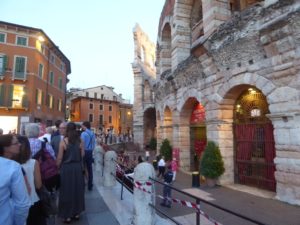
The first 20th century operatic production at the Arena was a staging of Verdi’s Aida, which took place on 10 August 1913, with musical luminaries such as Puccini and Mascagni in the audience. Since then, summer seasons of opera have taken place continuously there, only suspended in 1915-18 and 1940-45 when Europe was convulsed in war.
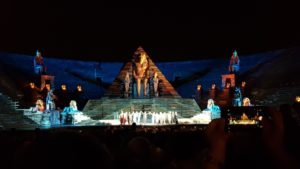
These days, the capacity of the Arena is limited to 15,000 due to safety reasons. Over the years, many great international stars such as Maria Callas, Giuseppe di Stefano, Tito Gobbi, Renata Tebaldi and Luciano Pavarotti—who performed in Verdi’s Un Ballo in Maschera at the Arena in 1972—have performed there.
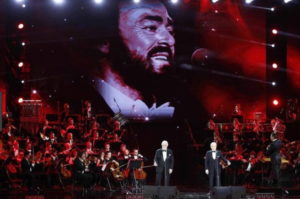
On 6th September 2017, marking ten years to the day since he died, the Luciano Pavarotti 10th Anniversary Concert was held in the Arena to celebrate the life, work and music of the great tenor. Performers included the legendary Plácido Domingo and José Carreras. At one point, they performed alongside old video footage of the ‘Three Tenors’, bringing the three of these great singers back together once again.
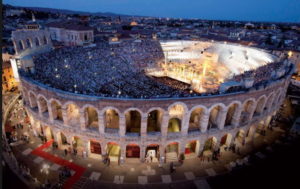
However, the Arena is also renowned as a great venue for rock concerts, with big names such as Bruce Springsteen, Pink Floyd, One Direction, The Who, Dire Straits, Sting, Rod Stewart, Leonard Cohen, Adele and Paul McCartney performing there.
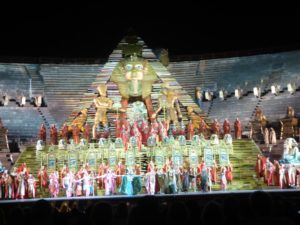
For opera lovers, the iconic opera to see at the Arena would probably have to be Verdi’s Aida. Its sheer size makes it the perfect space in which to perform an opera such as Aida which at one point has a show-stopping “crowd scene”, where some productions actually manage to have elephants leading the ‘Triumphal March’. Regrettably, there were no elephants in this year’s production! Despite this shortcoming, there were lavish, highly imaginative sets, wonderful costumes in a production that dazzled the eye with every scene—nothing minimalist, pared back or post-modern here.
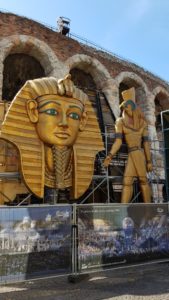
The interesting thing we remarked on was that the production, by Italian film director Franco Zeffirelli, was not merely one that had been transposed from an indoor venue, but instead took full advantage of the enormous scale of the Arena, especially using the steeply tiered seating and walls as part of the set, to great visual effect.
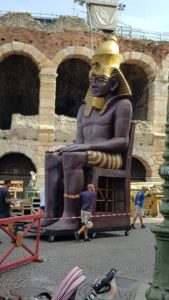
The morning after our performance we whiled away time watching the Aida sets from the night before being removed and the sets for that night’s Barber of Seville being installed, undertaken with military precision. All this had to be done by crane, up and over the walls, since the huge size of the sets and props wouldn’t fit through any of the entrances. An absolutely fascinating sight, and great fun lining up for photos alongside Rameses ll, a couple of pyramids and huge sphinxes.
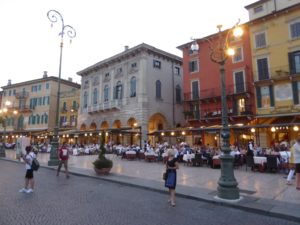
For those contemplating buying a ticket for a future season, just bear in mind that Verona is not far from the Dolomites and thus experiences weather patterns typical of mountainous regions. Take a lightweight raincoat, or buy one of those oh-so-becoming plastic ponchos, in a suitably lurid colour of course, ”just in case”. We know a number of people who have experienced a rain shower, either delaying the start or even mid-performance. Understandably, the whole orchestra and performers scuttle off-stage to shelter, and by the time the rain ceases, the stage swept of water and the performance resumes, it can end up being quite a late night. A recommendation is to eat before the performance, as dinner could be very late indeed if rain has delayed or interrupted the show.
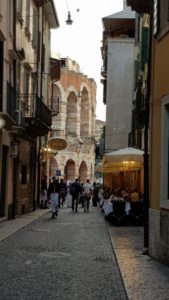
Note that the summer opera season at the Arena runs from late June through to the first week of September. The atmosphere throughout the city at this time is very festive, shops stay open quite late and restaurants offer pre and post-opera menus.
Another suggestion is to buy tickets for the stalls, or floor, of the Arena rather than the tiered stone benches, which are certainly cheaper, but a long way from the stage. In our view, even A reserve seats were very reasonably priced—and much more comfortable—and visibility was excellent. The audience was a mix of international visitors but also a great many Italians, who were easy to spot, being on the whole the best-dressed patrons there!
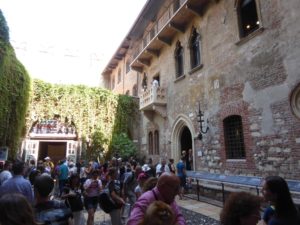
Aside from the Arena, the other main attraction is the Romeo & Juliet theme, which draws thousands to the city throughout the year. It also appeared to us that many people were firmly convinced that Romeo and Juliet were real, historical figures, rather than figments of Shakespeare’s vivid imagination. Juliet’s house, with ‘The’ balcony, as well as Juliet’s ‘tomb’ are huge tourist drawcards.
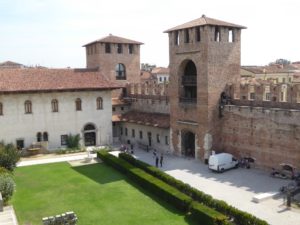
As well as, or despite all that, Verona is one of Italy’s northern gems, and justifiably inscribed on UNESCO’s World Heritage List. Certainly the Roman Arena is the headline site, but there are so many wonderful architectural treasures such as the vast Castelvecchio, built in 1354 as a military fortress for the Scaliger dynasty that ruled Verona in the Middle Ages, and now housing the Verona Museum.
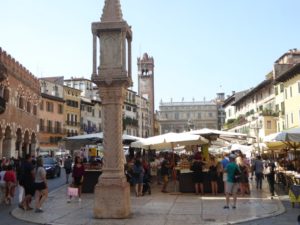
There’s the Piazza delle Erbe, originally the Roman forum known as the Domus Meratorum, now the location of the delightful outdoor market; numerous palazzi such as the Barbieri Palace, now the Town Hall, built on the site of a Roman temple; there’s the majestic baroque Gran Guardia Palace, the Maffei Palace and the Gardello Tower.
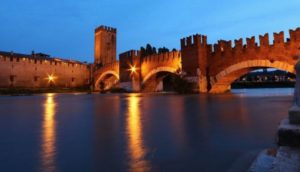
One of the most spectacular sights in the city must be the medieval Ponte Scaligero. This bridge was built over the river Adige by the della Scala family at the same time as the construction of their Castelvecchio fortress in order to defend the city, but also to have a possible escape route northwards during turbulent times.
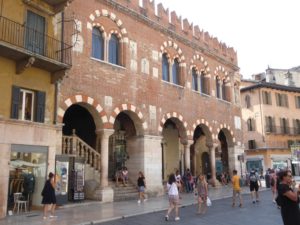
There’s so much to see and do in Verona, it’s well worth spending a couple of days enjoying all the sights of this picturesque and lively city, with its rich historical heritage and vibrant cultural life.
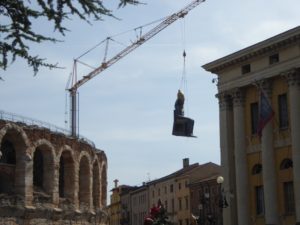


Fascinating as always
The sight of Ramses II (well, I like to think it was him, rather than just your common, garden variety Pharaoh!), the Great Pyramid of Giza et al soaring through the air on a huge crane, up and over the walls of the Arena just added to the whole fantastic experience! We’d love to do it all again one day soon.